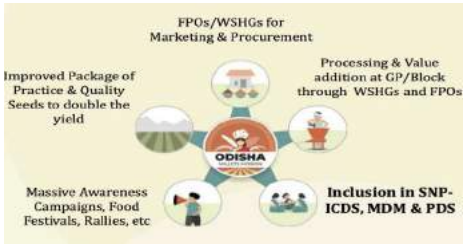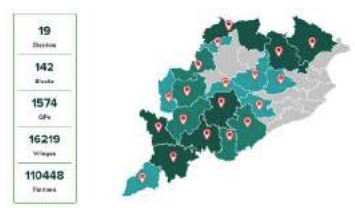Odisha Millets Mission
Odisha Millets Mission
Summary of the Initiative
The Government of Odisha launched the special programme for promotion of millets in tribal areas known as Odisha Millet Mission (OMM) in 2017 with aim to Revive Millets on Farms and Plates and simultaneously focus on production, processing, consumption, marketing and inclusion of millets in Government Schemes
Situation before the Initiative
Data from NFHS-4 shows that Odisha ranks in the top 10 of the most affected States of under-five year child malnutrition on all the three indicators of wasting, stunting and underweight. In terms of deprivations and marginalization, the State also has some of the highest proportion of tribals (24%) in the country with higher malnutrition levels with the relationship strongest for underweight children.
Further, farmers are shifting towards cultivation of high profiting commercial crops like cotton, maize, paddy, vegetables etc., which created a void in millet cultivation. Moreover, change in food habits, drudgery in processing of millets, lack of storage facilities, and lack of support from the Government led to declining in area under cultivation and consumption of millets. These problems triggered the formation of Millet mission.
Some of the key issues related of the millet production cycle are as follows:
- Decrease in household consumption of millets
- Low productivity of millets due to lack of innovation in improved agronomic practices and limited availability of good quality seed of suitable landraces
- Lack of decentralized processing units that could reduce drudgery
- Limited millet market linkages
Nature of The Initiative
 Odisha Millet Mission (OMM) was initiated in 2017 to promote Millets (Ragi) as a staple crop of the farming system. Emerging from a consultation between the State government, academia and civil society, it is the first project in the Agriculture and Farmers Empowerment Department with simultaneous focus on production, processing, consumption, marketing, and inclusion of millets in Government Schemes
Odisha Millet Mission (OMM) was initiated in 2017 to promote Millets (Ragi) as a staple crop of the farming system. Emerging from a consultation between the State government, academia and civil society, it is the first project in the Agriculture and Farmers Empowerment Department with simultaneous focus on production, processing, consumption, marketing, and inclusion of millets in Government Schemes
The objectives of OMM are as follows:
- Promoting household level consumption
- Improving productivity of millet crops by improved agronomic practices
- Promoting FPOs for marketing
- Setting up decentralized processing unit
- Inclusion of millets in ICDS, MDM and PDS
Entire project is implemented by FPOs with support of local NGOs under the guidance of line departments at district and block level.
Impact of the Initiative
 Reach and Scale of OMM: The Mission was started with 30 Blocks (7 Districts) in 2017 but due to positive response and demand from the farmers it was expanded to 55 Blocks (11 Districts) in 2018 to 142 Blocks (19 Districts) in currently.
Reach and Scale of OMM: The Mission was started with 30 Blocks (7 Districts) in 2017 but due to positive response and demand from the farmers it was expanded to 55 Blocks (11 Districts) in 2018 to 142 Blocks (19 Districts) in currently.
Millets are being cultivated in 54495.83 hectares, with ragi occupying over 86% of area. More than 11 lakhs farmers have taken up millet cultivation through improved agronomic practices. During Kharif marketing season of 2021-22, OMM has procured 3,23,000 quintals(3,2300MT) of millets from 41,286 farmers. Around 76 Farmer Producer Organizations have been registered under OMM. Odisha has conducted 45 Participatory Varietal Trails and identified 103 unique traditional and 14 unique improved varieties.
Ragi was distributed under PDS to more than 50 lakh beneficiaries in 14 districts. OMM envisages addressing both supply side and demand side aspects of millet use. The initiative is unique as it leverages on a range of stakeholders in the farm and tribal development space, including community-based organizations, grassroot level NGOs and technical advisors. A key component of the programme is also the incentive structure put in place using the direct benefit transfer model where farmers who follow the recommended practice are provided a conditional cash transfer. To summarize whole mission achievements, the following key achievements should be highlighted:
- Gross value of produce per farmer household increased over three times, from Rs.3957 to 12486 during from 2018-19 to 2020-21.
- Gross value of produce per hectare increased more than 2 times, from Rs. 9447 to 20710, millet production per hectare increased over 2 times from 5.79 quintal/hectare (0.6MT/hectare) to 12.72 quintal/hectare (1.3 MT/hectare). Average area in hectare per farmer household increased from 0.42 hectare to 0.60 hectare per household from 2018-19 to 2020-21.
During a review meeting held in August 2021, the Hon’ble Chief Minister has approved the extension of the 5-year programme period and expansion of the program into new blocks and districts for the next phase of OMM. The scaling up of procurement and inclusion of millet in ICDS, MDM and PDS has also been approved. Odisha was declared “Best Millet Promoting State” under “Poshak Anaj Awards” by ICAR-IIMR and FAO. The State Planning Commission of Chhattisgarh has asked the Government of Chhattisgarh to start a millet mission on the lines of “Odisha Millets Mission”. In fact, the Government of India has set up a task force to understand the framework of the Odisha Millets Mission and to revise the National Sub Mission on millets based on the learnings of the OMM. Cambridge University partnered with Odisha Millets Mission to explore possibility of design of OMM as alternative to Green Revolution framework.
Introduction of Ragi Laddu in ICDS: Ragi laddu has been introduced as a morning snack for pre-school children under ICDS in Keonjhar and Sundargarh. Ragi Laddu now covers 7066 anganwadi centres and 1,50,682 preschool children.
Millet Shakti Cafe: Cafes have been established across Odisha, called Millet Shakti Cafe to serve the millet-based hot cooked items and bakery products. More than 45 events have been organized and millet-based food items have been served to 4.4 lakh people in the last two years.
Income Generation: As seen from Table 5, assured income from Government supported ragi procurement has helped develop markets with remunerative prices for rainfed produce. This in turn has led to a revival of ragi cultivation across several areas multiplying the increase in income. The FPO, a farmer led body to ensure improvement of production and productivity, provide platform for small and marginal millet farmers to collectively sell processed grains and value added products of millets. The FPOs successfully deal with challenges and constraints that confront farmers by leveraging collective strength and bargaining power to access financial and non-financial inputs, services, and appropriate technologies, reduce transaction costs, tap high-value markets, and enter into partnerships with private entities on more equitable terms
Increase in MSP of Millets (Rs)6 from 2017-18 to 2021-22
| Year/Crops | Ragi | Bajra | Jowar (Hybrid) | Jowar (Maldandi) |
| 2017-18 | 1900 | 1425 | 1700 | 1725 |
| 2018-19 | 2897 | 1950 | 2430 | 2450 |
| 2019-20 | 3150 | 2000 | 2550 | 2570 |
| 2020-21 | 3295 | 2150 | 2620 | 2640 |
| 2021-22 | 3377 | 2250 | 2738 | 2758 |
Nutritional Security: The objective of Odisha Millets Mission is to revive millets on farms and on plates. Ragi procurement has supported the consumption among people. As mentioned above, the procured ragi based entitlements were included in the PDS and ICDS Schemes. These efforts are set to be expanded through inclusion of ragi based preparations in MDM. Hence, the focus has been on the nutritionally vulnerable category of children.
Gender and Nutrition Benefits: Mechanized and decentralized processing of millets at block level has helped increasing ease of doing agriculture and in reducing women’s drudgery in producing millets.
Climate Resilience: The assured market for finger millet has led to an increase in area under millet production. This has increased farmers’ resilience in the face of drought. Deficient rainfall posed a problem for paddy cultivation but has had no impact on non-paddy crops.
Last Modified : 5/11/2024
Provides overview of farm machinery available for...
This topic provides information about Hybrids and ...
This topic provides information about Comprehensiv...
This topic highlights the importance of nutrient r...
